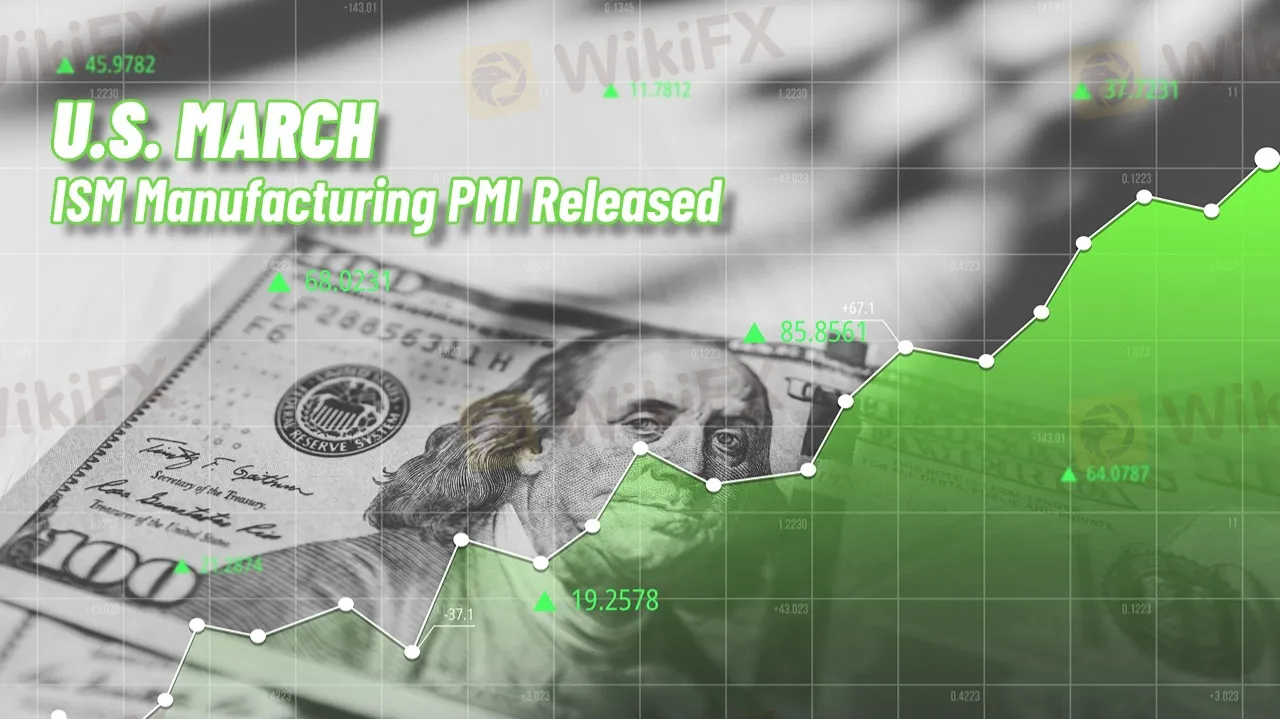简体中文
繁體中文
English
Pусский
日本語
ภาษาไทย
Tiếng Việt
Bahasa Indonesia
Español
हिन्दी
Filippiiniläinen
Français
Deutsch
Português
Türkçe
한국어
العربية
U.S. March ISM Manufacturing PMI Released
Abstract:The U.S. March ISM Manufacturing PMI data shows that manufacturing has contracted for the first time, and investors should pay attention to future changes and impacts on the sector.

According to the ISM manufacturing PMI data released on April 1, the U.S. manufacturing sector has contracted for the first time, with the price index surging, indicating the risk of an economic slowdown. Investors should closely monitor future developments and impacts on manufacturing.
The March ISM manufacturing PMI dropped to 49, lower than the expected 49.5 and down from 50.3 in February. A reading of 50 is considered the dividing line between expansion and contraction, meaning U.S. manufacturing is experiencing a downturn. At the same time, the price index rose sharply by 7 points to 69.4, reaching its highest level since June 2022. This increase highlights growing production cost pressures, especially from rising raw material prices.
The weakness in factory orders and employment indicators further emphasizes the impact of insufficient demand on the manufacturing sector, with the factory orders index falling to 45.2, the lowest level since May 2023.
These data suggest that the challenges facing U.S. manufacturing are intensifying, particularly due to the dual effects of tariff policies and weak demand. While certain industries are still showing growth, the overall signs of economic slowdown are becoming more pronounced, and the outlook for manufacturing is not optimistic.
For investors, the current market is filled with uncertainty, and it is essential to adjust investment strategies prudently. Focus on defensive sectors, such as utilities and consumer staples, which may offer more stable returns.
Meanwhile, the commodity market, especially metals and energy commodities, may be impacted by price fluctuations, and investors should assess risks and consider appropriate investment opportunities. Future economic data will be key to assessing the direction of the economy.

Disclaimer:
The views in this article only represent the author's personal views, and do not constitute investment advice on this platform. This platform does not guarantee the accuracy, completeness and timeliness of the information in the article, and will not be liable for any loss caused by the use of or reliance on the information in the article.
Read more

March Oil Production Declines: How Is the Market Reacting?
Oil production cuts in March are reshaping the market. Traders are closely watching OPEC+ decisions and supply disruptions, which could impact prices and future production strategies.

How to Calculate Leverage and Margin in the Forex Market
Leverage amplifies both potential profits and risks. Understanding how to calculate leverage and margin helps traders manage risks and avoid forced liquidation.

USD/INR, USD/PHP Forecast April 2025
The global forex markets are bracing for April 2025 with divergent forecasts for key emerging market pairs. In particular, the USD/INR and USD/PHP pairs have attracted significant attention amid a mix of central bank interventions, evolving U.S. policy signals, and regional economic shifts. In this article, we review multiple forecasts, examine the driving factors, and outline what traders might expect as the month unfolds.

April Forex Trends: EUR/USD, GBP/USD, USD/JPY, AUD/USD, USD/CAD Insights
Know April’s forex seasonality trends for EUR/USD, GBP/USD, USD/JPY, AUD/USD, and USD/CAD. Historical insights and key levels to watch in 2025.
WikiFX Broker
Latest News
Exposing the Top 5 Scam Brokers of March 2025: A Closer Look by WikiFX
Gold Prices Climb Again – Have Investors Seized the Opportunity?
Webull Launches SMSF Investment Platform with Zero Fees
Australian Regulator Warns of Money Laundering and Fraud Risks in Crypto ATMs
The Withdrawal Trap: How Scam Brokers Lure Victims into Paying More
FCA to Investors: Think Twice Before Trusting These Brokers
Trump\s tariffs: How could they affect the UK and your money
Trump gambles it all on global tariffs he\s wanted for decades
HTFX Spreads Joy During Eid Charity Event in Jakarta
How Will the Market React at a Crucial Turning Point?
Currency Calculator







